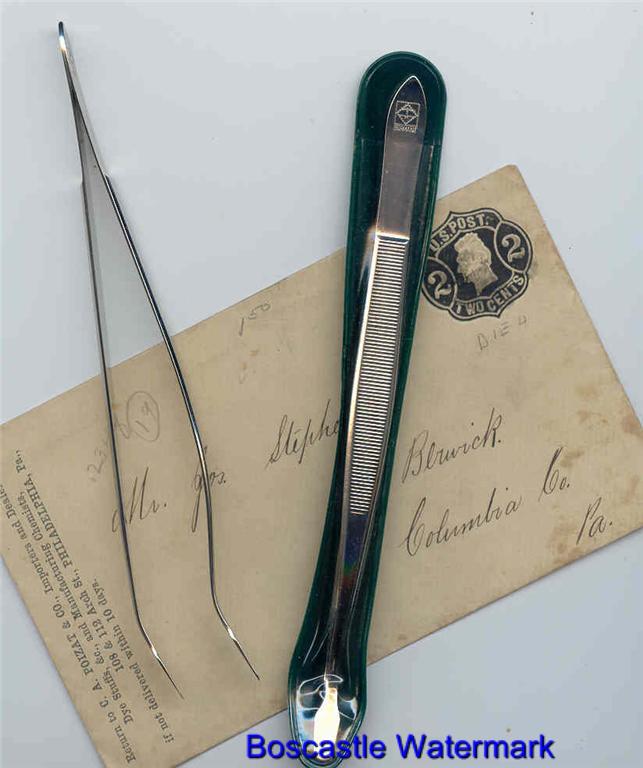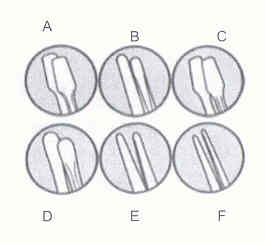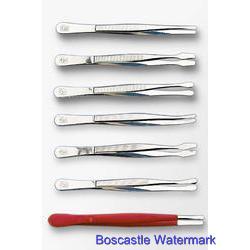This is the first of several stamp collecting articles Boscastle Stamp Collecting Supplies will publish over the next few months about all subjects relating to the buying and using of various stamp supplies, stamp accessories and stamp albums.

Also, if the stamp has some gum or is mint never hinged (MNH) the gum should not be disturbed in any way with a moist finger print, grease, dirt or any skin oils.
Ensure the tips of the stamp tongs are in the centre of the stamp and not touching the perforations, as they can be easily damaged.

We sell thousands of stamp tongs to customers all around the world each year.
Our most popular stamp tongs are the 5” Bent Spade or Shovel and the 5” Pointed Tip. We note that some collectors like to buy two different types of stamp tongs at the same time to test drive them and choose later which to get comfortable with.

Check out Shop Here For Stamp Tongs and Stamp Tweezers for a large selection of stamp tongs and tweezers, ranging in price from $2.50 to $12.95.

We know it can be quite intimidating for a new collector to go into a stamp store, or go to a stamp show, and ask the busy dealer questions about some of the basics of stamp collecting and how to properly use the equipment. And when faced with a huge selection or array of products to choose from the decision for the collector is made a lot harder.
In these articles we hope to unravel some of the mysteries of why you should use various supplies and accessories, and we’ll try and make the selection of which one to buy a little easier.
Our goal is to make the stamp collecting hobby more accessible and enjoyable for juniors and beginners, for collectors who are rediscovering the hobby later in age, and to remind more serious philatelists about the basics.
What are stamp tongs?
Stamp tongs are an essential tool used by stamp collectors and philatelists around the world. “Stamp tongs” is the name primarily used in North America, while “stamp tweezers” is the preferred name in much of Europe, especially in the UK.
While stamp tongs are similar in shape to the domestic tweezers you might find in the bathroom for cosmetic or medical use, they are however very different in that they do not have sharp or serrated ends which can actually damage a stamp. Therefore household tweezers should not be used instead of stamp tongs as they often damage stamps.
The best stamp tongs are always made of metal, with plastic versions suitably available for children. They are generally made of two flat metal pieces, joined together at one end to create a spring action that allows the free ends to pinch together with a smooth surface to hold the stamp.
Many of the premium stamp tong brands have a thick nickel coating on them to prevent rusting and corrosion and will last a typical stamp collector a life time. Premium stamp tongs tend to be manufactured in Solingen, Germany and can come under many different brands.
If your budget can take a few more dollars, or you have rare stamps deserving the royal treatment then gold plated stamp tongs are top quality, will never tarnish and feel nice when using them. Additionally, coloured stamp tongs, in red, green and blue are appearing on the market.
Why use stamp tongs?
A pristine stamp can be irretrievably damaged by even the most careful handling, ruining a beautiful item and lowering its value. Even the most delicate touch risks bending your stamp or damaging the perforations. That’s why we need to use stamp tongs.
Stamp tongs and stamp tweezers are universally used by stamp collectors and philatelists around the world because they are a reliable and safe way to hold a very delicate and small piece of paper without damaging it or getting skin oils on them.
Even after washing hands, a light coating of skin oil can transfer to the surface of the stamp and this can stain the printed design, either immediately or by reacting with the ink over time. If you have damp or sweaty fingers, or you live in a hot or tropical climate, you have to use stamp tongs to take care of your stamps.
Also, if the stamp has some gum or is mint never hinged (MNH) the gum should not be disturbed in any way with a moist finger print, grease, dirt or any skin oils.
Any defect found on a stamp may detract from its value and may hurt the stamp more as it ages.
Stamp tongs can also be very efficient at handling large numbers of stamps when sorting them into piles, putting them into stamp albums, envelopes or stockbooks, and when mounting them. They are the perfect tool for gently gripping a stamp to hold it up to the light, or to examine it closely for watermarks, perforations or paper marks and errors.
Stamp tongs can also be very efficient at handling large numbers of stamps when sorting them into piles, putting them into stamp albums, envelopes or stockbooks, and when mounting them. They are the perfect tool for gently gripping a stamp to hold it up to the light, or to examine it closely for watermarks, perforations or paper marks and errors.
We recommend that stamp collectors inspect their tongs from time to time to make sure they are clean and free from damage. Tongs that are properly handled will last for many years, but they should be replaced if they show any defect to the tips, such as a kink or a dent which could transfer a mark onto a stamp.
How to use stamp tongs
Stamp tongs are easy to use. The basic technique is to slide the tong along the surface of the table top with one tip going underneath the stamp and then pinch the other tip onto the front surface of the stamp.
Apply the right amount of pressure and hold the stamp securely between the tong tips, but don't apply too much pressure when pinching the tongs together, otherwise a mark may appear on the paper of the stamp.
Ensure the tips of the stamp tongs are in the centre of the stamp and not touching the perforations, as they can be easily damaged.
If you’re new to stamp collecting try practicing using the tongs on small torn up pieces of paper, flipping them around and sorting them into piles, until you’re comfortable using the tongs.
Different types of stamp tongs
Stamp tongs can range in length between 10-20 cm (4-8 inches). The most popular stamp tong lengths are 3-1/2” for juniors and small hands, 5” for beginners and 6” for professionals.
Check out Shop Here For Stamp Tongs and Stamp Tweezers for a large selection of stamp tongs and tweezers, ranging in price from $2.50 to $12.95.
The tip is usually thin, polished smooth and rounded, so it can slide under a stamp easily, without damaging the most delicate and rarest of stamps. They may come in several different tip shapes, some bent and some straight, as illustrated in the diagram below.

A – Spade or Shovel Tip
B – Pointed Tip
C – Bent Spade or Shovel
D – Round Tip
E – Professional Point
F – Lethal Point
Which stamp tong do you choose to buy?
While there is a stamp tong available for every budget, choosing a stamp tong to use with your stamp collection is a personal preference, based upon your hand size, hand dexterity and stamp tong experience.
We sell thousands of stamp tongs to customers all around the world each year.
Our most popular stamp tongs are the 5” Bent Spade or Shovel and the 5” Pointed Tip. We note that some collectors like to buy two different types of stamp tongs at the same time to test drive them and choose later which to get comfortable with.

Check out Shop Here For Stamp Tongs and Stamp Tweezers for a large selection of stamp tongs and tweezers, ranging in price from $2.50 to $12.95.
Here are our recommendation for choosing stamp tongs:
Size – 5” tongs are suitable for most adults. If you are handling thousands of stamps and need extra leverage for twisting, flipping and turning stamps, then the 6’ stamp tong will suffice.
Tip Type – Again with experience, the flat, spoon, spade or shovel type will give you extra grip, and give your stamps the most protection. A pointed stamp tong can damage, pierce, or tear a stamp if not properly used, but they are more tactile, mobile and finer to use, and therefore the pointed types tend to be used by professionals more.
Which type of stamp tong does Boscastle Supplies use?
We use the 6” lethal stamp tong at Boscastle Supplies when handling stamps, we find we have finer control over the stampwhen flipping it and turning it around, it’s also easier to use when using stockbooks and stockpages, requiring less wrist pressure when using them for hours on end.
Check out Shop Here For Stamp Tongs and Stamp Tweezers for a large selection of stamp tongs and tweezers, ranging in price from $2.50 to $12.95.
If you have any opinions, questions or comments about this article, please leave a reply. We'd love to hear from you.
Click here for a pdf of this article: http://www.boscastlesupplies.com/StampTongs.pdf
Source: David Terry / www.boscastlesupplies.com
If you have any opinions, questions or comments about this article, please leave a reply. We'd love to hear from you.
Click here for a pdf of this article: http://www.boscastlesupplies.com/StampTongs.pdf
Source: David Terry / www.boscastlesupplies.com




